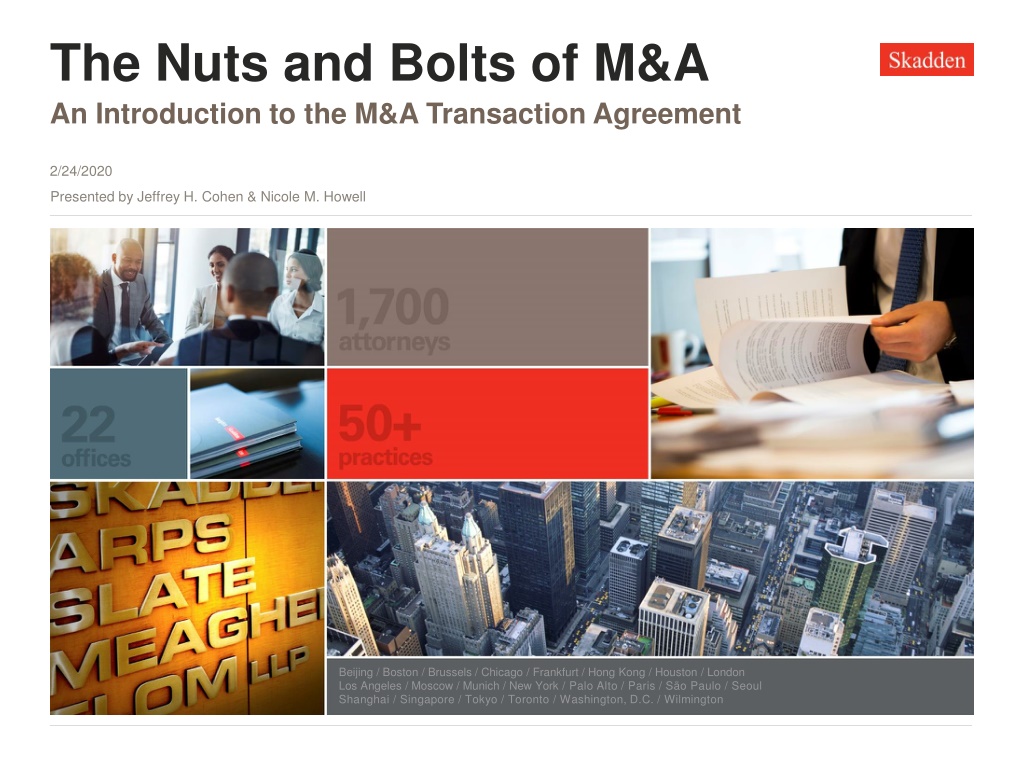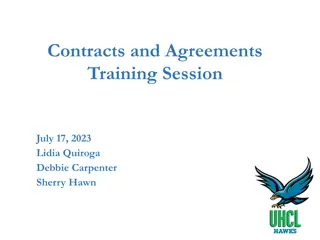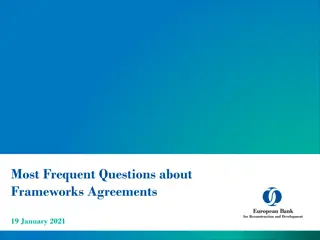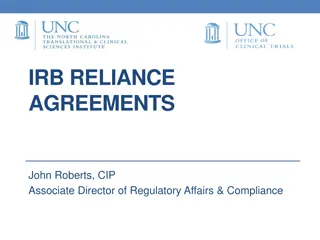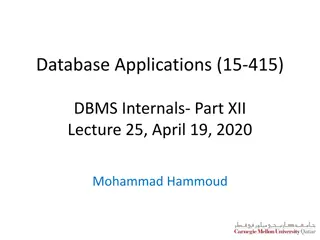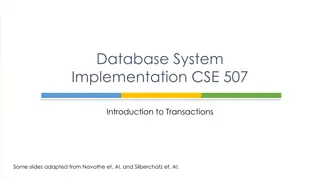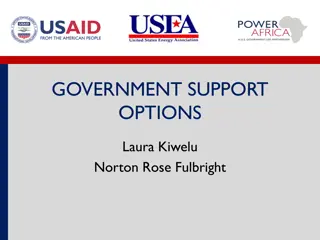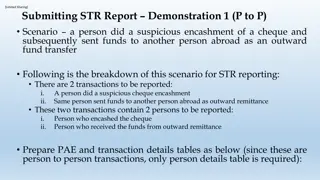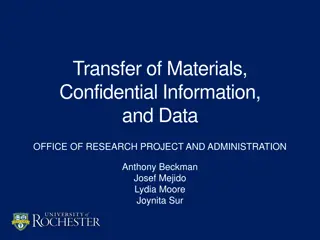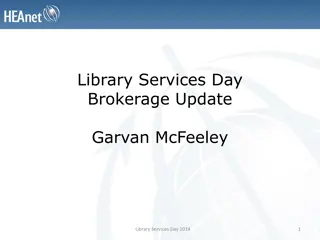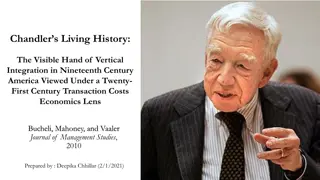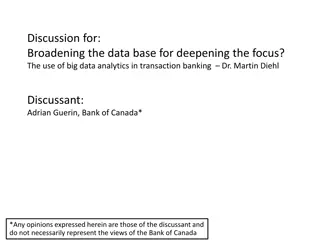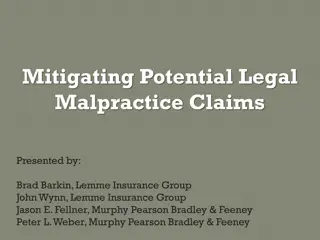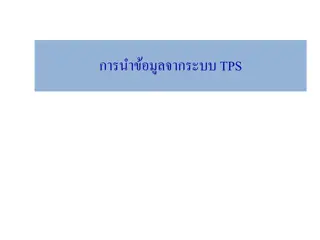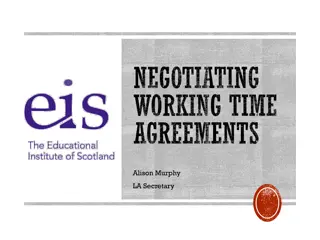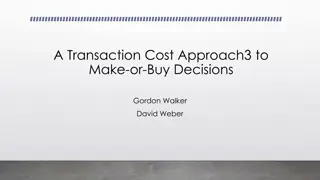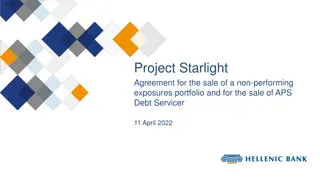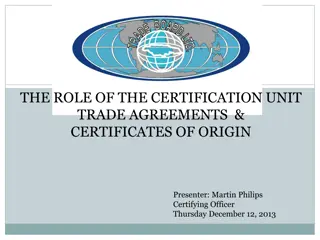Understanding M&A Transaction Agreements and Agreements Structure
This overview delves into the types of M&A transaction agreements, such as Stock Purchase Agreements and Merger Agreements, along with the basic agreement structure encompassing definitions, purchase price mechanics, representations, warranties, covenants, conditions, termination, and indemnification.
Download Presentation

Please find below an Image/Link to download the presentation.
The content on the website is provided AS IS for your information and personal use only. It may not be sold, licensed, or shared on other websites without obtaining consent from the author. Download presentation by click this link. If you encounter any issues during the download, it is possible that the publisher has removed the file from their server.
E N D
Presentation Transcript
The Nuts and Bolts of M&A An Introduction to the M&A Transaction Agreement 2/24/2020 Presented by Jeffrey H. Cohen & Nicole M. Howell Beijing / Boston / Brussels / Chicago / Frankfurt / Hong Kong / Houston / London Los Angeles / Moscow / Munich / New York / Palo Alto / Paris / S o Paulo / Seoul Shanghai / Singapore / Tokyo / Toronto / Washington, D.C. / Wilmington 1 Skadden, Arps, Slate, Meagher & Flom LLP and Affiliates The Nuts and Bolts of M&A: An Introduction to the M&A Transaction Agreement
Introduction 1 2 Skadden, Arps, Slate, Meagher & Flom LLP and Affiliates The Nuts and Bolts of M&A: An Introduction to the M&A Transaction Agreement
Introduction Types of Transaction Agreements Principal Transaction Agreements Stock Purchase Agreement Asset Purchase Agreement Merger Agreement Disclosure Schedules Ancillary Transaction Agreements Escrow Agreement Stockholders Agreement Transition Services Agreement Financing Documents Commercial Agreements Non-Competition and Non-Solicitation Agreements 3 Skadden, Arps, Slate, Meagher & Flom LLP and Affiliates The Nuts and Bolts of M&A: An Introduction to the M&A Transaction Agreement
Introduction Basic Agreement Structure Preamble / Recitals Definitions Purchase Price / Mechanics Representations and Warranties Covenants Conditions Termination Indemnification (if applicable) General Provisions / Miscellaneous 4 Skadden, Arps, Slate, Meagher & Flom LLP and Affiliates The Nuts and Bolts of M&A: An Introduction to the M&A Transaction Agreement
Purchase Price / Mechanics 2 5 Skadden, Arps, Slate, Meagher & Flom LLP and Affiliates The Nuts and Bolts of M&A: An Introduction to the M&A Transaction Agreement
Purchase Price / Mechanics Purchase price / consideration (cash / stock / notes) Closing date adjustments (e.g., working capital, net assets) Escrows / hold-backs (e.g., purchase price adjustment, indemnification) Consideration can be contingent or deferred Mechanics for sale of stock / assets; merger Closing deliverables 6 Skadden, Arps, Slate, Meagher & Flom LLP and Affiliates The Nuts and Bolts of M&A: An Introduction to the M&A Transaction Agreement
Representations and Warranties 3 7 Skadden, Arps, Slate, Meagher & Flom LLP and Affiliates The Nuts and Bolts of M&A: An Introduction to the M&A Transaction Agreement
Representations and Warranties Functions Signing Closing Diligence Termination Indemnification Diligence to assist Buyer in understanding the business it is acquiring and in doing its due diligence Buyer may learn new facts about the business through exceptions to the representations, which appear on the disclosure schedules Buyer may seek purchase price adjustment, renegotiate certain aspects of the deal or decide not to do the deal at all Termination to allow Buyer to refuse to close the deal if the representations are not true at closing If the snapshot shown by the representations at signing turns out not to be true at closing, Buyer may be able to terminate the agreement Indemnification to enable Buyer to recover damages if a representation turns out to be false after closing 8 Skadden, Arps, Slate, Meagher & Flom LLP and Affiliates The Nuts and Bolts of M&A: An Introduction to the M&A Transaction Agreement
Representations and Warranties Public vs. Private Public deals have relatively few affirmative representations (e.g., a list of material contracts) and have significantly fewer representations in general Public companies are already subject to disclosure obligations Generally no post-closing indemnification in public deals Representations in private deals are generally more specific and detailed and there are more affirmative representations requiring disclosure schedules Private companies are generally not subject to disclosure obligations, so due diligence and negotiation of reps and warranties help identify issues Post-closing indemnification is common in private deals 9 Skadden, Arps, Slate, Meagher & Flom LLP and Affiliates The Nuts and Bolts of M&A: An Introduction to the M&A Transaction Agreement
Representations and Warranties Categories Representations as to the agreement and parties Cover the technical points and facts relevant to the parties ability to perform (e.g., organization, capacity and authority to enter into the agreement; no conflicts or violation of law; enforceability) Representations as to the business Cover facts about the specific subject matter of agreement (i.e., that Buyer is getting what it bargained for) Examples include capitalization, financial statements, no undisclosed liabilities, material contracts, compliance with laws, taxes, litigation, etc. 10 Skadden, Arps, Slate, Meagher & Flom LLP and Affiliates The Nuts and Bolts of M&A: An Introduction to the M&A Transaction Agreement
Covenants 4 11 Skadden, Arps, Slate, Meagher & Flom LLP and Affiliates The Nuts and Bolts of M&A: An Introduction to the M&A Transaction Agreement
Covenants Introduction A covenant is an agreement between the parties Distinct from representations Can be mutual or unilateral Covenants serve different purposes depending when they are made Pre-closing covenants Restrictions on conduct of business being acquired between signing and closing > Protects the business from material changes between signing and closing Actions to be taken in order to consummate transaction; obligation of a party to perform in a particular manner Post-closing covenants Regulates ongoing relationship between the parties for a period of time post-closing May also be contained in ancillary agreements like Transition Services Agreement, Registration Rights Agreement, etc. 12 Skadden, Arps, Slate, Meagher & Flom LLP and Affiliates The Nuts and Bolts of M&A: An Introduction to the M&A Transaction Agreement
Covenants Conduct of Business Governs behavior between signing and closing Affirmative covenants thou shall Conduct business in the ordinary course Use best efforts to maintain business and relationships Negative covenants thou shall not Prohibits certain non-ordinary course activities (e.g., selling stock, incurring material amounts of debt, amending material agreements or entering into new material agreements, selling assets, settling litigation) without Buyer s consent Exceptions listed in disclosure schedules 13 Skadden, Arps, Slate, Meagher & Flom LLP and Affiliates The Nuts and Bolts of M&A: An Introduction to the M&A Transaction Agreement
Covenants Best Efforts / Required Consents Parties required to use efforts to satisfy closing conditions Commitment to make all required filings in a timely manner Allocation of responsibility for obtaining consents typically Seller to cooperate with Buyer in obtaining required consents Types of consents Antitrust Standard for obtaining antitrust approvals is a negotiated point (e.g., hell or high water vs. no divestitures vs. divestitures up to a specified amount) Industry regulators (e.g., banking, insurance, gaming, alcohol, transportation) Contractual consents from third parties CFIUS (Committee on Foreign Investment in the United States) Stockholder approval 14 Skadden, Arps, Slate, Meagher & Flom LLP and Affiliates The Nuts and Bolts of M&A: An Introduction to the M&A Transaction Agreement
Covenants No Shop Fiduciary duties obligate Seller s board of directors to obtain the highest price reasonably attainable for Seller s stockholders A no shop restricts Seller and its representatives from shopping the company More typical in public deals Cannot solicit competing bids, provide information to competing bidders or engage in related discussions Common exceptions to the no shop address fiduciary duty issues: Window shop Fiduciary out Go shop 15 Skadden, Arps, Slate, Meagher & Flom LLP and Affiliates The Nuts and Bolts of M&A: An Introduction to the M&A Transaction Agreement
Covenants Other Examples Financing Access to Information Notification of Certain Matters Employee Matters Non-Compete / Non-Solicit / No Hire Confidentiality Commercial Arrangements Director and Officer Indemnification and Insurance 16 Skadden, Arps, Slate, Meagher & Flom LLP and Affiliates The Nuts and Bolts of M&A: An Introduction to the M&A Transaction Agreement
Conditions 5 17 Skadden, Arps, Slate, Meagher & Flom LLP and Affiliates The Nuts and Bolts of M&A: An Introduction to the M&A Transaction Agreement
Conditions Introduction A closing condition provides one or both parties the right to refuse to close the deal if not satisfied Conditions can be mutual or one way When coupled with a termination right, may provide a party with a walk-away right Some conditions call for specific deliverables while other conditions are factual Common conditions include: Absence of injunctions / litigation Regulatory and third-party approvals Bring-down of representations, warranties and covenants No MAE (absence of a material adverse change) Stockholder approval Financing Execution of ancillary agreements (including key employment agreements) 18 Skadden, Arps, Slate, Meagher & Flom LLP and Affiliates The Nuts and Bolts of M&A: An Introduction to the M&A Transaction Agreement
Conditions Bring-Down A bring-down condition requires that representations and warranties made by a party be true and correct as of the closing date (and possibly the signing date) Materiality standards: The bring-down may be qualified by a materiality or MAE standard Buyer will want certain representations that are fundamental (e.g., corporate organization, capitalization, Seller s authority, title) not to be qualified by materiality or MAE 19 Skadden, Arps, Slate, Meagher & Flom LLP and Affiliates The Nuts and Bolts of M&A: An Introduction to the M&A Transaction Agreement
Conditions No MAE Condition will typically reference the absence of a Material Adverse Effect since the signing date Describes change in a party s circumstances (usually the target) that allows the other party to walk away prior to closing Generally covers a party s business, operations, financial condition, assets and (sometimes) liabilities Concept also used to qualify and test bring-down of representations Exceptions include industry-wide or U.S. economy-wide changes and changes in financial markets, stock price / analyst forecasts, law or GAAP, or resulting from transaction announcement or war / terrorism Occurrence of an MAE is very difficult to prove 20 Skadden, Arps, Slate, Meagher & Flom LLP and Affiliates The Nuts and Bolts of M&A: An Introduction to the M&A Transaction Agreement
Conditions Other Examples Financing Stockholder approval If Buyer is issuing more than 20% of its outstanding stock in a transaction, NYSE and Nasdaq require stockholder approval, subject to certain exceptions Magnitude of sale or structure of transaction may give rise to requirement to obtain stockholder approval under state law Due diligence It is more typical for the parties to complete due diligence prior to entering into a definitive transaction agreement 21 Skadden, Arps, Slate, Meagher & Flom LLP and Affiliates The Nuts and Bolts of M&A: An Introduction to the M&A Transaction Agreement
Termination 6 22 Skadden, Arps, Slate, Meagher & Flom LLP and Affiliates The Nuts and Bolts of M&A: An Introduction to the M&A Transaction Agreement
Termination Introduction Termination rights can be mutual or unilateral Difference between termination rights and closing conditions Conditions provide a basis not to close but do not relieve obligations Termination right relieves a non-defaulting party of its obligations (other than those that expressly survive termination) Termination events or triggers Mutual agreement of Buyer and Seller Permanent injunction blocking transaction Breach of rep, warranty or covenant resulting in closing condition failure Drop dead or outside date In public deals: Superior proposal / fiduciary out Failure to obtain stockholder approval 23 Skadden, Arps, Slate, Meagher & Flom LLP and Affiliates The Nuts and Bolts of M&A: An Introduction to the M&A Transaction Agreement
Termination Remedies Break-up fee Common in public deals; rare in private deals In a public deal, size of fee payable by Seller will be limited in light of case law Obligation to pay fee based on various triggers (e.g., Seller s board changes its recommendation, Seller exercises fiduciary out termination right) Reverse break-up fee Some deals include reverse break-up fees payable by Buyer in certain circumstances Originated in private equity buyout transactions to address financing risks and use of shell companies as acquisition vehicles; sometimes appear in strategic transactions Damages Most transaction agreements allow parties to seek damages following termination, but typically for only a limited set of breaches (e.g., material, willful or intentional, or fraud) Specific performance Specific performance is intended to permit a party to force the other party to perform Avoids need to establish damages and provides Seller the full benefit of its bargain 24 Skadden, Arps, Slate, Meagher & Flom LLP and Affiliates The Nuts and Bolts of M&A: An Introduction to the M&A Transaction Agreement
Indemnification 7 25 Skadden, Arps, Slate, Meagher & Flom LLP and Affiliates The Nuts and Bolts of M&A: An Introduction to the M&A Transaction Agreement
Indemnification Introduction Provides basis for post-closing liability and recourse for breaches Applies to breaches of representations, warranties and covenants Common in private deals, though not all private deals include indemnification ( public-style deals) Provides for risk allocation of contingencies (unknown and/or identified) Tension between Buyer s desire for protection (or benefit of the bargain ) and Seller s desire for finality; often involves complex negotiation Sometimes covers specified contingencies or specific indemnities (e.g., liabilities for existing lawsuits, outstanding tax matters) Rep and warranty insurance has emerged to shift risk from the parties to third-party insurers 26 Skadden, Arps, Slate, Meagher & Flom LLP and Affiliates The Nuts and Bolts of M&A: An Introduction to the M&A Transaction Agreement
Indemnification Survival Seller wants uncertainty eliminated and Buyer wants a reasonable opportunity to discover any basis for indemnification Defines the period for making indemnification claims Generally within a one- to two- year range Buyer often desires enough time to complete at least one post-closing audit (theory is that many hidden liabilities will be flushed out during that time period) 27 Skadden, Arps, Slate, Meagher & Flom LLP and Affiliates The Nuts and Bolts of M&A: An Introduction to the M&A Transaction Agreement
Indemnification Limitations Baskets (alternative to dollar one recovery): Deductible (a/k/a basket ): Minimum dollar amount that must be exceeded before any indemnification is owed Threshold (a/k/a tipping basket ): Indemnity from dollar one once exceeded Mini-Baskets (de minimis per claim thresholds): Damages from indemnifiable matter or series of related matters must exceed X before recovery and/or to count against deductible / threshold Purpose is to avoid administrative hassle of multiple small claims and avoid nickel and diming Cap: Maximum aggregate amount recoverable by the indemnified party 28 Skadden, Arps, Slate, Meagher & Flom LLP and Affiliates The Nuts and Bolts of M&A: An Introduction to the M&A Transaction Agreement
Indemnification Escrow Multiple Sellers: Escrow is important where enforcing the indemnity may be difficult If there is a diverse set of Sellers, an escrow simplifies recovery mechanics in joint and several scenario Amount of Escrow: No magic formula / transaction dependent Duration: Term rarely exceeds indemnification period and may be shorter (but should last until any claims for indemnification and against escrow have been paid or finally adjudicated) Escrow may be released in stages over time Exclusive Remedy: Consider whether the escrow should be the exclusive remedy for breaches of representations and warranties; provides protection and additional certainty for Sellers 29 Skadden, Arps, Slate, Meagher & Flom LLP and Affiliates The Nuts and Bolts of M&A: An Introduction to the M&A Transaction Agreement
Other General Provisions Jurisdiction; Service of Process; Arbitration Specific Performance Waiver; Entire Agreement and Modification Assignment No Third-Party Beneficiaries Governing Law 30 Skadden, Arps, Slate, Meagher & Flom LLP and Affiliates The Nuts and Bolts of M&A: An Introduction to the M&A Transaction Agreement
Questions? Skadden, Arps, Slate, Meagher & Flom LLP and Affiliates 31 Skadden, Arps, Slate, Meagher & Flom LLP and Affiliates The Nuts and Bolts of M&A: An Introduction to the M&A Transaction Agreement
